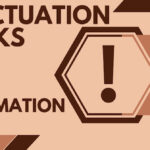Introduction
In the world of writing, punctuation marks play a crucial role in expressing emotions and adding emphasis to sentences.
One such punctuation mark that stands out is the exclamation point or exclamation mark.
Often used to indicate strong feelings or emotions, an exclamation point can drastically alter the tone of a sentence.
This article aims to provide readers with a better understanding of what exclamation punctuation marks are, their significance in writing, how they are used, and when it is appropriate to use them.
Definition of Exclamation Punctuation Marks
Exclamation marks are one of the most recognizable punctuation marks in written language. They are represented by an upside-down line with a dot beneath it (!).
The primary function of this mark is to express strong emotions such as excitement, astonishment, joy, or anger. When used correctly, an exclamation point can enhance the emotional impact and overall tone of a sentence.
Importance Of Using Exclamation Marks In Writing
Using exclamation points serves several critical purposes in writing.
First and foremost, they capture and convey emotions that might be challenging to express using words alone.
For example:
“I am so happy!” expresses more excitement than “I am happy.” With an increased level of emotion comes an increased level of reader engagement.
Secondly, an exclamation point adds emphasis and asserts authority in writing.
It signals to readers that certain parts need special attention or highlight key points in your message.
While it should not be overused because it may lose its effect on readers when employed too often.
Overall, using an exclamatory punctuation mark effectively requires a thorough understanding of its purpose and usage rules so as not to undermine your message’s effectiveness.
Explanation of Exclamation Punctuation Marks
Exclamation marks, also known as exclamation points, are a type of punctuation mark that is used to indicate strong emotions.
The function of exclamation marks is to add emphasis and convey excitement, surprise, anger, or other intense feelings in written language.
Exclamation marks are found primarily in informal writing such as emails, text messages, or social media posts.
Compared to other punctuation marks like periods or commas, exclamation marks have a much stronger impact on the reader.
They can completely change the tone of a sentence and add emotion or urgency where it may not have been present before.
In addition to conveying strong emotions, exclamation marks can also be used for emphasis and clarity.
For example, a sentence like
“I really need you to come here now” becomes more urgent and clear if written as “I really need you to come here now!”
It is important to note that while exclamation marks can add energy and emphasis to writing when used properly, overusing them can dilute their impact and make writing appear juvenile or overly dramatic.
Therefore it’s important for writers to use them selectively and only when necessary.
Uses of Exclamation Punctuation Marks
Exclamation punctuation marks are primarily used to express strong emotions or feelings such as excitement, anger, surprise, or joy. They are often used to convey a sense of urgency and can help to emphasize the importance of a statement.
For example
if you were excited about an upcoming event, you might use an exclamation mark to convey your enthusiasm:
“I can’t wait for the concert next week!”
Another common use for exclamation punctuation marks is to add emphasis to a sentence or word for dramatic effect.
This is especially useful in creative writing and storytelling where the aim is often to engage and captivate the reader’s attention.
For example, if you were writing a story about a character who had just discovered something shocking, you might use an exclamation mark after their dialogue to emphasize their surprise:
“What?! This changes everything!”
In addition, exclamation marks can also be used to indicate commands or requests in an assertive tone.
This is particularly useful in instructional writing where it’s important that readers follow specific steps or directions carefully.
For example
if you were writing a recipe book and wanted readers to know they must add salt before mixing the ingredients together, you could use an exclamation point at the end of your instruction
: “Add salt before mixing!” Overall, using exclamation punctuation marks correctly can greatly enhance your writing by adding depth and emotion.
However, it’s important not to overuse them as this can diminish their impact. By understanding how and when to use them appropriately, you will be able to communicate your message more effectively through your writing.
Rules for Using Exclamation Punctuation Marks
Use sparingly to avoid overuse and loss of impact
While exclamation marks can be a powerful tool in conveying strong emotions, they should be used sparingly to avoid losing their impact.
Overuse of exclamation marks can seem unprofessional or suggest that the writer is overly emotional or not in control. It’s always important to think about the context of your writing and how often you’re using exclamation marks.
For example, if you’re writing dialogue for a character who is consistently excited or angry, it may be more appropriate to use exclamation marks with more frequency.
However, in other types of writing such as formal documents or academic papers, it’s essential to use them only when necessary.
Avoid using in formal writing unless necessary
While exclamation marks can add emphasis and express enthusiasm, it’s essential to avoid using them unnecessarily in formal writing such as academic papers or business documents.
In most cases, these types of texts require a more neutral tone and professional language. Overusing exclamation marks can come across as unprofessional and undermine the credibility of the writer.
However, there are times when using an exclamation mark may be necessary even in formal writing.
For example, if the text requires expressing extremely positive or negative feelings such as excitement about a new discovery or frustration with a long-standing problem.
Do not use with questions or statements that are already exclamatory
A common mistake made by writers is using an exclamation mark on a sentence that is already forceful enough without one. This can make the text appear overconfident or even aggressive.
It’s also important to note that while some questions may seem like they require an exclamation mark due to their emotional content; they should never have one at the end of them because question punctuation is not interchangeable with exclamation point punctuation.
For instance, a sentence such as “Why did you do that?!” doesn’t require an exclamation mark because the question mark already conveys the writer’s emotional tone.
However, a sentence such as “You won!” could potentially benefit from an exclamation mark to convey excitement or enthusiasm.
It’s important to use exclamation marks with moderation and thoughtfulness in order to effectively convey emotions and add emphasis without undermining the professionalism of the writing.
Example Sentences with Exclamation Punctuation Marks
Exclamation marks are used to convey strong emotions and feelings in a sentence, and they can be a powerful tool in writing. Here are some examples of how exclamation marks can be used effectively to add emphasis and emotion to a sentence:
1) “I can’t believe we won the game!” exclaimed Sarah.
In this example, the exclamation mark is used to convey excitement and disbelief. Without the exclamation mark, the sentence would simply state that Sarah was surprised about winning the game.
However, with the addition of an exclamation mark, the reader can better understand just how thrilled Sarah is about the situation.
2) “Stop right there!” shouted the police officer.
This example uses an exclamation mark to convey urgency and authority. The police officer’s command becomes more forceful because of the added punctuation.
Without it, it may seem like a simple request rather than an order that needs immediate attention.
3) “Wow! That’s amazing news,” said John.
In this example, the exclamation mark adds emphasis to John’s reaction to hearing amazing news.
It conveys his excitement much more effectively than if he had simply said “That’s amazing news.” The use of an exclamation point amplifies his emotional response and makes it clear just how happy he is about what he heard.
The Power of Exclamatory Phrases
While using an exclamation point at the end of a sentence is effective for conveying strong emotions or surprise, using exclamatory phrases throughout your writing can also add impact and energy. Here are some examples:
1) “How incredible!” exclaimed Mary. In this example, Mary uses an exclamatory phrase instead of just one word with an exclamation point at the end of her statement.
This gives her statement even more emphasis because it creates a sense of anticipation leading up to the exclamation.
2) “You won’t believe what happened!” said Tom.
Tom’s use of an exclamatory phrase at the beginning of his sentence creates a sense of urgency and excitement. The reader is immediately drawn into the conversation because they want to know what happened.
3) “I am so thrilled to meet you!” said Lisa. In this example, Lisa uses an exclamatory phrase to convey her excitement and enthusiasm.
By including this phrase, she conveys her emotions more effectively than if she had simply said “Nice to meet you.” Overall, using exclamation punctuation marks and exclamatory phrases can add depth and emotion to your writing.
However, it is important to use them sparingly and appropriately in order to maintain their impact. When used correctly, they can make your writing more engaging and memorable for your readers.
The Importance of Properly Using Exclamation Punctuation Marks
Exclamation punctuation marks are a powerful tool in written communication.
When used properly, they add emphasis to a sentence, convey strong emotions, and create a sense of urgency or excitement. However, the misuse of exclamation marks can lead to confusion and misunderstanding, diluting their impact and reducing their effectiveness.
One important rule to keep in mind when using exclamation punctuation marks is to use them sparingly. Overuse can make writing seem juvenile or unprofessional and may even cause readers to become annoyed or confused.
It’s also important to avoid using exclamation marks in formal writing unless absolutely necessary. Another key aspect of proper use is knowing when not to use an exclamation mark.
Avoid using them with statements that are already exclamatory or with questions that require an answer rather than expressing a strong emotion.
By understanding these guidelines for proper usage, writers can effectively harness the power of exclamation punctuation marks to communicate their message with clarity and impact.
A Final Thought: The Power of Effective Written Communication
Effective written communication is crucial in today’s world where so much business is conducted online through email and social media platforms like Twitter and Instagram.
Understanding how to use punctuation properly can greatly enhance the effectiveness of your written communication, allowing you to convey your message clearly and persuasively.
By mastering the proper use of exclamation punctuation marks, writers can add depth and nuance to their writing while ensuring that their message is heard loud and clear.
Whether you’re seeking better engagement on social media or trying to persuade potential clients through email correspondence, knowing how to wield this powerful tool will help you achieve success in all your written communications.





3 thoughts on “Exclamation Punctuation Marks”